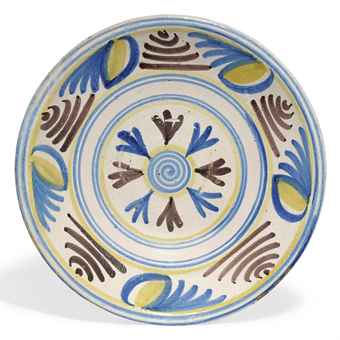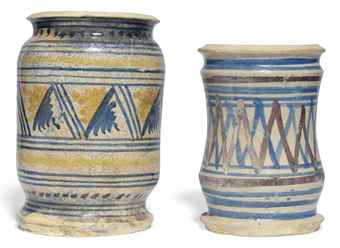Delftware is my favourite pottery find, perhaps because it is so old, 1560-1750 yet
its hand painted designs are so vibrant, bold and modern, similar to the
Spanish and Portuguese pottery seen on holiday. Several pieces I've found are also quite quirky. The unfamiliar, poetic names of
the original objects enthrall, puzzle jugs, fuddling cups, bleeding bowls, porringers, flower bricks, posset-pots, blue chargers, drug jars.
 |
| A favourite find, delftware pottery approx 4cm with childlike design |
 |
| Tin glazed dish
1571-1800 Museum of London |
Delftware was first produced in London from 1571 by
two Antwerp potters, Jacob Jansen and Japser Andries, who opened a pottery at
Aldgate. During the 17th century several potteries were
established close to the Thames in Southwark (in the wonderfully named Pickleherring Quay) , Lambeth, Vauxhall and Rotherhithe and later at Putney and Wapping. The
best delft descriptions I've found are from Judith Miller, antiques expert, author and TV
presenter, so many direct quotes from her,
‘Delftware is a type of earthenware characterised by its
opaque white enamel glaze, made from a mixture of tin and lead ash, powdered
glass and water.Before the development of this revolutionary enamel, British
potters had been severely restricted in terms of decoration by the drab browns
and greens of the clays they used. The clean white finish of Delftware allowed
them to paint patterns, landscapes and portraits for the first time.They painted their naive designs in bright colours derived
from various minerals - cobalt blue was the most widely employed, although
copper green, manganese purple, iron red and antimony yellow were also used.’
 |
| Polychrome delftware shards found mudlarking on Thames foreshore |
 |
| English Delft Polychrome Dish 1675-1700, Christies |
Drug jars, wine bottles, and ointment pots were typically produced in the 17th century
 |
| Delft Drug Jars Early 17th Century, Christies |
 |
| Delftware, some with manganese purple found mudlarking on Thames foreshore |
In the 18th century tea bowls, pots, cups and saucers were made. They were the possessions of the middle classes, status symbols, shown off in the best rooms rather than kept in the kitchen.
In the latter part of the 18th century, Josiah Wedgwood promoted his more industrially produced tableware, which chipped less easily and was decorated in the new classical style, the public responded eagerly and delftware went out of production by the early 19th century.







Thank you so much for this connection. I have been making a papier-mache dish inspired by a fragment of Delft similar to this that I also found on The Thames foreshore. This helps me enormously.
ReplyDeleteGlad it was of use, I noticed that you'd made it mudlarking on the Thames and were now making jewellery from your finds, looks like you have got the bug too! Julia
Delete